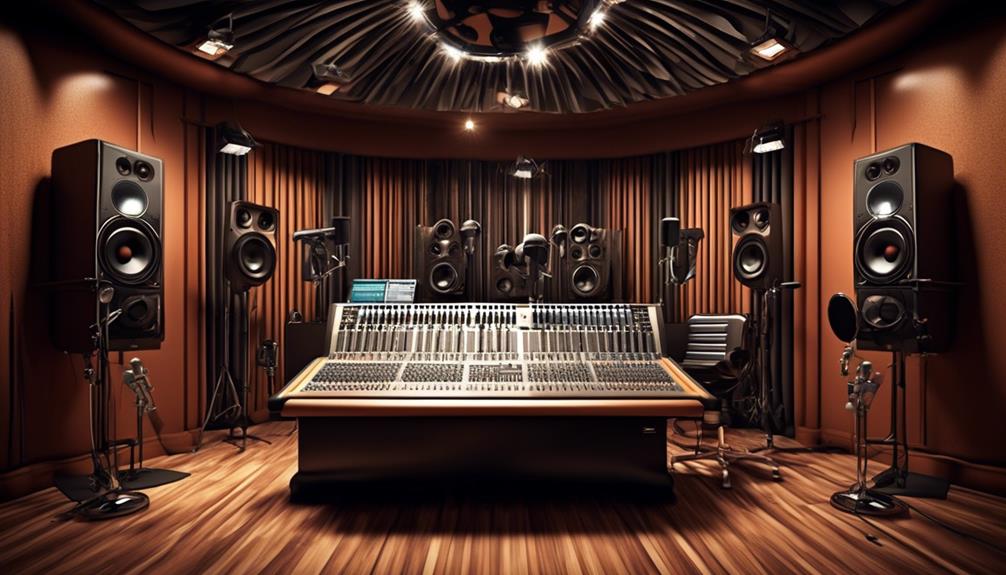Have you ever stopped to think why music is recorded in stereo, a fact that we often overlook?
Stereo recording isn't just a matter of convenience or aesthetics; it actually plays a crucial role in how we perceive and experience music.
There's a fascinating science behind the decision to use stereo, and understanding it can deepen our appreciation of the music we love.
Let's explore the reasons behind this fundamental aspect of the recording process and uncover the impact it has on our enjoyment of music.
Key Takeaways
- Stereo recording enhances the auditory experience by capturing a three-dimensional sonic environment.
- It provides depth and width in audio, creating a natural and dynamic sound.
- Stereo recording enables the localization of sound sources, enhancing the perception of instruments and vocals.
- It replicates natural ambience and reverberation, immersing the listener in the music.
Evolution of Stereo Recording
The evolution of stereo recording began with the demonstration of the first two-channel audio system in Paris in 1881, marking a significant milestone in the development of stereophonic sound. This early innovation laid the foundation for the future of audio recording, enabling the creation of a true stereo image through the use of left and right speakers.
As the technology progressed, the concept of stereo recording expanded, allowing for a more immersive audio experience. The introduction of stereo mix techniques further enhanced the quality of stereo recordings, enabling engineers to manipulate the audio to achieve a balanced and dynamic sound.
Throughout the years, advancements in stereo recording have revolutionized the way audio is captured and reproduced. From the invention of stereo records and films by Alan Blumlein to the integration of stereo recording into motion pictures, the evolution of stereo recording has continuously pushed the boundaries of audio technology.
The introduction of Dolby Stereo further expanded the possibilities of stereo sound, providing a multi-channel audio experience that elevated the quality of audio in non-anamorphic widescreen films. These developments have shaped the landscape of modern audio recording, offering unparalleled fidelity and realism in the reproduction of sound.
Benefits of Stereo Recording

Exploiting the spatial properties of sound, stereo recording technology enhances the auditory experience by capturing and reproducing a three-dimensional sonic environment. When a sound source is recorded in stereo, it allows for a more immersive and realistic listening experience.
Stereo recordings provide a sense of depth and width in the audio, creating a more natural and dynamic sound. By using two microphones to capture the sound, stereo recording enables the localization of sound sources, enhancing the perception of instruments and vocals by separating them in the stereo field. This separation replicates the way we naturally hear sound, providing a more engaging and realistic listening experience.
Additionally, stereo recordings can replicate the natural ambience and reverberation of a space, further immersing the listener in the music. When played back through stereo speakers, the benefits of stereo recording are fully realized, as the spatial information captured during recording is accurately reproduced, creating a captivating and lifelike sonic environment.
Stereo Recording Techniques
Utilizing advanced microphone placement and signal processing, stereo recording techniques enable the capture of multi-directional, three-dimensional audio perspectives with precision and fidelity.
When employing stereo recording techniques, it's crucial to consider:
- Microphone Placement:
- Utilize spaced pair microphone techniques to capture a wide stereo image with natural spaciousness.
- Implement coincident pair microphone techniques, such as XY and MS, to ensure mono compatibility and precise stereo imaging.
- Signal Processing:
- Apply equalization to balance the frequency response between the left and right channels.
- Utilize time-based effects, like reverb and delay, to enhance the sense of space and depth in the stereo field.
When recording in stereo, it's essential to consider the playback systems and the intended listening environment. Stereo recordings are optimized for playback through two speakers, creating a sense of sound coming from different directions. Additionally, it's crucial to ensure mono compatibility to maintain the integrity of the audio when played through a single channel.
Understanding these stereo recording techniques is fundamental for achieving high-quality audio recordings and delivering an immersive listening experience.
Impact on Listening Experience

Stereo recordings significantly impact the listening experience by expanding the soundstage and enhancing the depth and localization of audio sources. When listening to stereo recordings through speakers or headphones, the impression of sound heard is remarkably different compared to mono tracks. The use of two audio channels in stereophonic recording allows for a more realistic reproduction of sound, mimicking the way we perceive audio in real life. Record labels and artists utilize stereo recordings to create a more immersive listening experience for the audience.
The impact of stereo recordings on the listening experience is profound. It allows for a more accurate representation of the spatial aspects of music, providing a sense of width and depth that isn't achievable with mono recordings. The separation and placement of instruments and vocals within the stereo field enhance the overall clarity, making the listening experience more enjoyable and engaging.
Additionally, stereo recordings can replicate natural ambience and reverberation, further enriching the quality of the audio. Whether it's the subtle ambiance of a live concert or the spatial positioning of instruments in a studio recording, stereo recordings truly elevate the listening experience.
Future of Stereo Recording
The future of stereo recording will likely be shaped by advancements in immersive audio formats, such as surround sound and 3D audio, to further enhance spatial and immersive qualities. As technology continues to evolve, stereo recording techniques will adapt to new listening environments and technologies.
Advancements in immersive audio formats:
- Surround sound and 3D audio will play a significant role in shaping the future of stereo recording, offering enhanced spatial and immersive qualities.
- These formats will enable sound to be heard from various directions, creating the impression of a three-dimensional audio space, thus revolutionizing the way we listen to music.
The demand for high-quality audio experiences will be a driving force in the continued relevance and development of stereo recording. Furthermore, advancements in virtual reality and augmented reality applications will rely heavily on realistic audio to create immersive experiences, thereby influencing the future of stereo recording.
As a result, the future of stereo recording will continue to cater to music enthusiasts valuing high-quality audio and realistic sound reproduction through the use of two speakers to create an immersive and lifelike auditory experience.
Frequently Asked Questions
Why Is Music in Stereo?
Stereo evolution has profoundly impacted music production.
Stereo technology revolutionized the way we experience music, enhancing stereo perception and offering a more immersive stereo experience.
Stereo innovation in production and mixing has elevated stereo aesthetics, providing a wider soundstage and precise instrument placement.
Stereo benefits include a more engaging and enjoyable listening experience.
Why Record in Stereo?
Recording in stereo offers numerous advantages over mono, such as creating a more immersive and dynamic soundstage. Stereo perception allows for a wider and more accurate representation of the original recording space.
Modern stereo equipment and mixing techniques have significantly improved stereo imaging and playback quality. Stereo technology has evolved to capture more realistic and detailed sound, enhancing the overall listening experience.
Is It Better to Record in Mono or Stereo?
When deciding between mono and stereo recording, we aim for a balanced sound perception. Stereo, with its dual channels and panning effects, provides spatial imaging that enhances the listening experience.
In music production, it allows for a more immersive mix, showcasing the depth and placement of instruments and vocals. It's like painting with a full spectrum of colors, enriching the sonic canvas. This approach demands advanced audio engineering and specialized equipment for a precise and captivating result.
What Is the Purpose of Stereo Sound?
The purpose of stereo sound is to enhance the listening experience by providing spatial perception and a balanced audio spectrum.
It creates an immersive listening environment with depth perception and natural sound.
Stereo sound offers a wide dynamic range and audio separation, allowing for directional sound and phantom images.
This technology provides a more realistic and detailed soundstage, enriching the overall auditory experience.
Conclusion
In conclusion, stereo recording has become the standard for music due to its ability to provide a more immersive and realistic listening experience.
The evolution of stereo recording techniques has greatly enhanced the depth and three-dimensionality of music, allowing for better sound localization and placement of instruments and vocals.
Despite the advancements in technology, it seems that the classic stereo recording will continue to be the preferred choice for music enthusiasts, proving that sometimes, the old ways are still the best.










